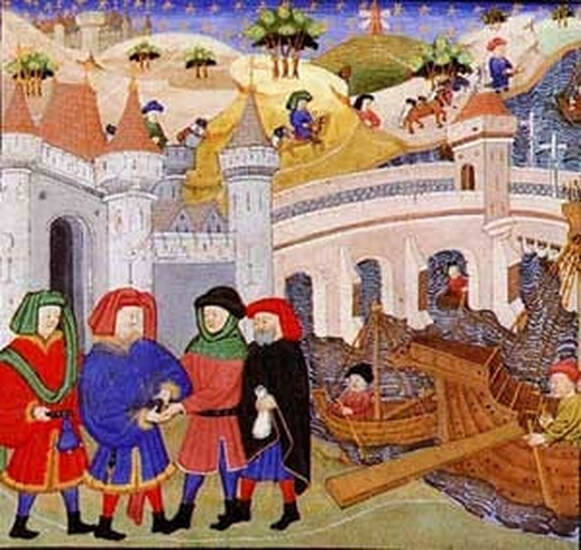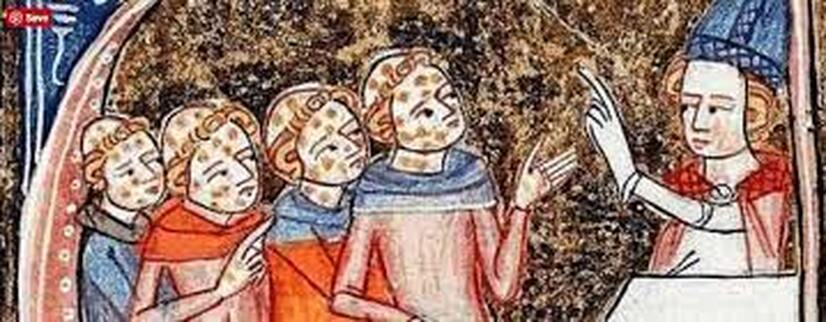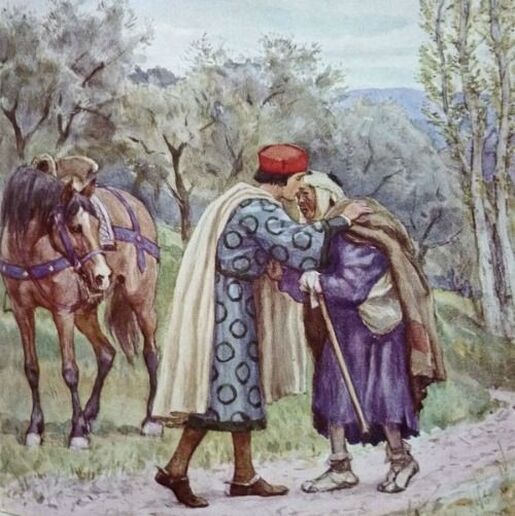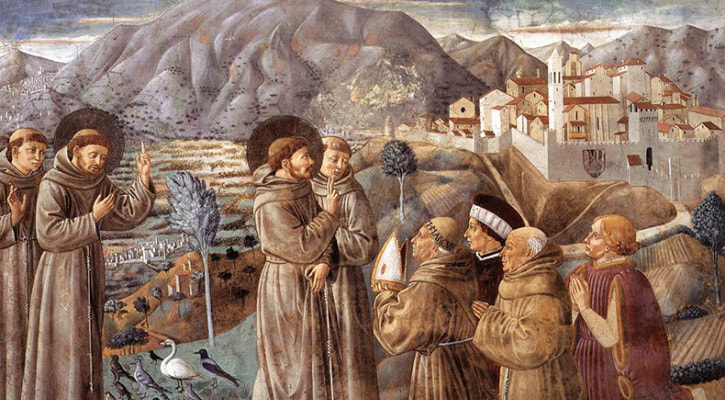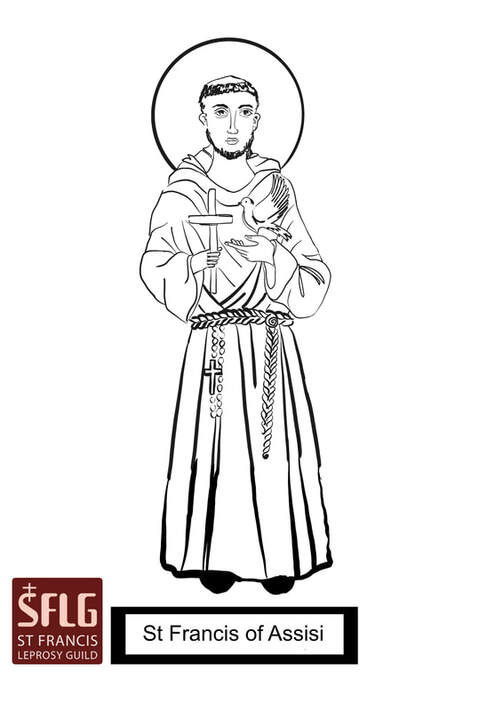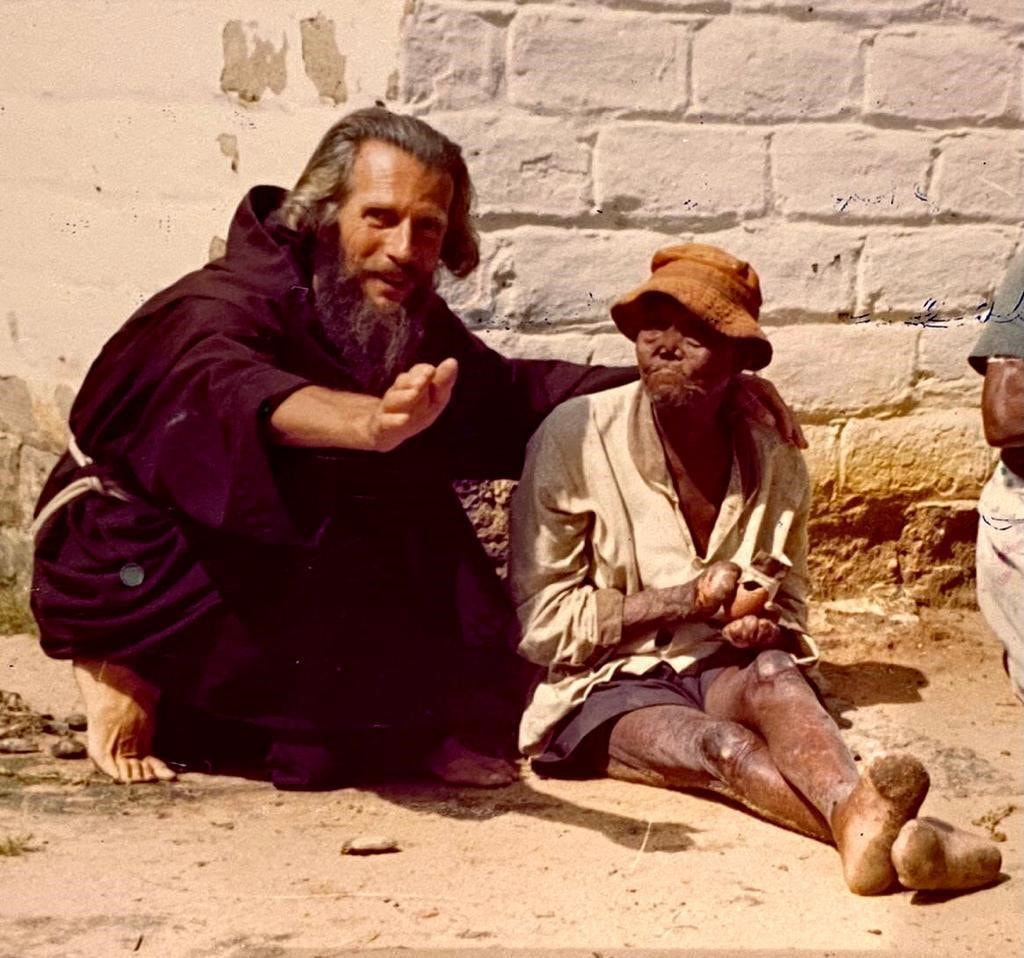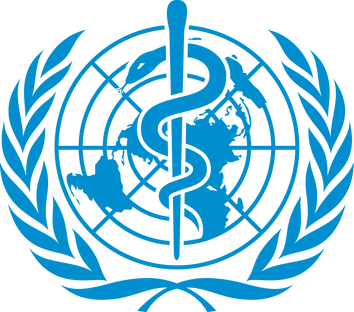NEWS UPDATE
Date: 4 October 2021
Date: 4 October 2021
SFLG commemorates the Feast Day of St Francis of Assisi
Today St Francis Leprosy Guild celebrates and reflects upon the Feast Day of its venerated patron, who died, aged 45, in 1226.
St Francis was born in the Italian town of Assisi, Umbria in 1182. Named Giovanni di Pietro di Bernardone, but known as Francesco, he was the son of a prosperous cloth merchant. A charismatic, charming man, he dressed to impress and display his wealth. He was a born leader of people with a retinue of followers who lived a life of privilege and excess.
St Francis was born in the Italian town of Assisi, Umbria in 1182. Named Giovanni di Pietro di Bernardone, but known as Francesco, he was the son of a prosperous cloth merchant. A charismatic, charming man, he dressed to impress and display his wealth. He was a born leader of people with a retinue of followers who lived a life of privilege and excess.
Francis was also a fastidious man; he loved beauty and hated deformity. He avoided people with leprosy whose poverty and smell he found obnoxious. He would make a wide circuit around the leprosarium in the valley below Assisi. His attitude was in tune with society's in general at that time, that people with leprosy did not count as people and were a threat to public health. There was also stigma attached to the disease and this included a judgement that people with leprosy were morally degenerate.
Francis could have spent his whole life with an attitude of prejudice except that his burgeoning Christian faith had taken hold. He pondered words from the Gospel like “For if you love those who love you, what right have you to claim any credit? Even the tax collectors do as much, do they not?”
One day while riding his horse on the plains below Assisi, he encountered a man with leprosy. A voice within Francis spoke out so loudly that he leapt of his mount and embraced the man.
One day while riding his horse on the plains below Assisi, he encountered a man with leprosy. A voice within Francis spoke out so loudly that he leapt of his mount and embraced the man.
This profound experience transformed his life, as Francis found himself freed from his prejudices against others. He could now be a brother to all people through his Christian faith.
Francis left his family and comfortable lifestyle to begin a new life of poverty. He wanted to follow what he considered to be God’s call. Francis preached about returning to God and obedience to the Church. Slowly others started to join him, men who wanted to follow his life of sleeping in the open, begging for food and loving God. His followers came from all walks of life, from the country and towns, noble and common, from universities, the Church, and the merchant class.
Francis left his family and comfortable lifestyle to begin a new life of poverty. He wanted to follow what he considered to be God’s call. Francis preached about returning to God and obedience to the Church. Slowly others started to join him, men who wanted to follow his life of sleeping in the open, begging for food and loving God. His followers came from all walks of life, from the country and towns, noble and common, from universities, the Church, and the merchant class.
Francis practiced true equality by showing honour, respect, and love to every person he encountered whether they were a beggar or a pope. He founded an Order or brotherhood of men called the Friars Minor (which means ‘lesser brothers’).
Francis' brotherhood included all of God's creation. Much has been written about Francis' love of nature, but his relationship was deeper than that. Francis really felt that nature, all God's creations, were part of his brotherhood. The humble sparrow was as much his brother as the pope.
Francis' brotherhood included all of God's creation. Much has been written about Francis' love of nature, but his relationship was deeper than that. Francis really felt that nature, all God's creations, were part of his brotherhood. The humble sparrow was as much his brother as the pope.
Francis did not try to abolish poverty, he tried to make it holy. When his friars met someone poorer than they, they would eagerly rip off the sleeve of their habit to give to the person. Francis would not let them accept money and told them to treat coins as if they were pebbles in the road. He said:
If we had any possessions, we should need weapons and laws to defend them." Possessing something was the death of love for Francis.
Also, Francis reasoned: "what could you do to a man who owns nothing? You can't starve a fasting man, you can't steal from someone who has no money, you can't ruin someone who hates prestige."
Later in life, Francis encountered persecution and martyrdom from his own kind. The Order had grown to more than 5,000 brothers in ten years. External pressures were forcing him to introduce controls, to make his Order conform to the standards of others. Francis’ dream of radical poverty was considered too harsh and eventually, he relinquished control.
Francis' later years were filled with suffering. Praying to share in Christ's passion, he had a vision that he received the stigmata, the marks of the nails and the lance wound that Christ suffered, in his own body.
Years of poverty and wandering had made Francis ill. Upon going blind, the pope ordered that his eyes should be operated on. That meant cauterizing his face with a hot iron. Francis spoke to Brother Fire:
Francis' later years were filled with suffering. Praying to share in Christ's passion, he had a vision that he received the stigmata, the marks of the nails and the lance wound that Christ suffered, in his own body.
Years of poverty and wandering had made Francis ill. Upon going blind, the pope ordered that his eyes should be operated on. That meant cauterizing his face with a hot iron. Francis spoke to Brother Fire:
Brother Fire, the Most High has made you strong and beautiful and useful. Be courteous to me now in this hour, for I have always loved you, and temper your heat so that I can endure it." Francis reported that Brother Fire had been so kind that he felt nothing at all.
Francis never completely recovered from his illness. He died on 4 October 1226 at the age of 45. He is considered the founder of all Franciscan Orders and the patron saint of animals, ecologists, and merchants. In addition to founding the men’s Order of Friars Minor, he founded the women’s Order of St Clare, the Third Order of St Francis, and the Custody of the Holy Land. St Francis is one of the most venerated figures in Christianity. He was canonized on 16 July 1228 by Pope Gregory IX.
There are more images of St Francis of Assisi than any other saint and there are more Franciscan martyrs than in any other religious order. St Francis is the most quoted saint. Why? All Franciscans are bonkers, and I include our saint in that… no argument about it” said Brother David Cunningham of the Franciscan Community of Our Lady of Compassion,
“My Blessed Father Francis said: “If God can work through me, God can work through anyone.” all I can say to that is, “Thank God.”
St Francis influenced the lives of many people, including John Bradburne, the Strange Vagabond of God and warden of Mutemwa leprosy community in Zimbabwe, until his death in 1979 at the hands of rebel soldiers. John was reported to have said that he had only three wishes: to help people affected by leprosy, die a martyr, and be buried in a habit of the Franciscan order. The centenary of his birthday, 14 June 2021, is currently being celebrated.
St Francis Leprosy Guild, Chief Executive Officer, Clare McIntosh said: “bonkers or not, St Francis embraced people with leprosy at a time when people with the disease were more ostracized, more outcast and more vilified than even today. Our patron was clearly following in the footsteps of Jesus, who also cared deeply for people with leprosy. SFLG takes up the task of caring for people with leprosy, in Francis name, today.”
Prayer of St Francis
For more information please contact:
Clare McIntosh
Chief Executive Officer
St Francis Leprosy Guild
London W10 6EJ
Tel: +44 (0)7754 592240
Email: [email protected]
Twitter @StLeprosy
Facebook
Clare McIntosh
Chief Executive Officer
St Francis Leprosy Guild
London W10 6EJ
Tel: +44 (0)7754 592240
Email: [email protected]
Twitter @StLeprosy
About St Francis Leprosy Guild (SFLG)
SFLG is a UK-based, Catholic charity that is working towards a -leprosy-free world. We support the work of over 40 leprosy centres, clinics, hospitals, care homes and leprosy-related projects. We work in 15 countries worldwide in Africa, Asia and South America where leprosy is endemic.
About leprosy
1. What is leprosy?
Leprosy (also known as Hansen’s disease) is a complex, chronic neglected tropical disease caused by the Mycobacterium leprae bacterium. It affects the skin, the upper respiratory tract and peripheral nerves in the hands and feet, and the eyes. Leprosy can affect anyone, at any age, but it is linked to poverty, malnutrition, and genetic susceptibility.
Leprosy remains an important health problem in low and middle-income countries worldwide.
2. How is leprosy transmitted?
It is thought that leprosy is transmitted via droplets from the nose combined with prolonged, close contact with infected individuals.
3. How is leprosy diagnosed?
Leprosy is difficult to diagnose at its early stages, but it often presents as numb patches on the skin. Currently, the most reliable method to diagnose leprosy, is a slit-skin-smear test in the laboratory.
Leprosy may incubate for up to twenty years before presenting with any signs. If leprosy remains undiagnosed like this, the person affected may unwillingly transmit the disease throughout a community. However, within a short period of receiving multidrug therapy, a person affected by leprosy will no longer be infectious. If leprosy is diagnosed in its early stages, it can be treated readily, and it will not cause disabilities. Preventing disabilities from developing means people with leprosy are less likely to suffer from the stigma and discrimination that can destroy their livelihoods and entire lives.
4. How infectious is leprosy?
95% of most populations have a natural immunity to leprosy. The remaining 5% become vulnerable, mainly through poor nutrition, poor living conditions, lack of hygiene and a weakened immune system. Leprosy is not hereditary.
5. Why are people with leprosy often so disfigured?
People with leprosy lose all feeling in the affected areas and as a result, there is diminished awareness of harm from trauma or heat. Without treatment, the lack of sensation can lead to permanent damage to skin, nerves, limbs, and eyes. It can also lead to the development of reoccurring, lifelong, hard-to- treat ulcers.
6. Is there a cure? How is leprosy treated?
Leprosy can be cured using multidrug therapy (MDT), available at no cost to patients from the World Health Organization. If MDT is taken in the early stages of the disease, permanent damage to nerves is completely avoided.
7. How many are affected by leprosy in the world today?
The latest *WHO statistics reveal that in 2019 there were 202,185 new cases of leprosy diagnosed. Of concern and indicating ongoing transmission, the number of children newly detected was nearly 15,000.
These statistics do not account for those people who have leprosy with no symptoms or, who are not diagnosed and are unwittingly transmitting it to their communities. In addition, the statistics do not include those individuals who have been treated for leprosy, but whose disabilities, caused by leprosy need ongoing healthcare needs, or those who are subject to leprosy stigma and discrimination.
8. Which countries have leprosy, where is leprosy endemic?
*The WHO has identified 23 global priority countries for leprosy, where 95.9% of the global total of people detected with leprosy are found. The 23 countries are: Angola, Bangladesh, Brazil, Comoros, Cote Ivoire, DR Congo, Egypt, Ethiopia, India, Indonesia, Kiribati, Madagascar, Micronesia, Mozambique, Myanmar, Nepal, Nigeria, Philippines, South Sudan, Sri Lanka, Sudan, Somalia and Tanzania.
The highest number of people newly detected with leprosy in 2019 live in India with 114,451, followed by Brazil with 27,863 and Indonesia with 17,439.
*WHO Weekly epidemiological record, Global Leprosy Update 4 September 2020, 36, 2020, 95, 417-440
SFLG is a UK-based, Catholic charity that is working towards a -leprosy-free world. We support the work of over 40 leprosy centres, clinics, hospitals, care homes and leprosy-related projects. We work in 15 countries worldwide in Africa, Asia and South America where leprosy is endemic.
About leprosy
1. What is leprosy?
Leprosy (also known as Hansen’s disease) is a complex, chronic neglected tropical disease caused by the Mycobacterium leprae bacterium. It affects the skin, the upper respiratory tract and peripheral nerves in the hands and feet, and the eyes. Leprosy can affect anyone, at any age, but it is linked to poverty, malnutrition, and genetic susceptibility.
Leprosy remains an important health problem in low and middle-income countries worldwide.
2. How is leprosy transmitted?
It is thought that leprosy is transmitted via droplets from the nose combined with prolonged, close contact with infected individuals.
3. How is leprosy diagnosed?
Leprosy is difficult to diagnose at its early stages, but it often presents as numb patches on the skin. Currently, the most reliable method to diagnose leprosy, is a slit-skin-smear test in the laboratory.
Leprosy may incubate for up to twenty years before presenting with any signs. If leprosy remains undiagnosed like this, the person affected may unwillingly transmit the disease throughout a community. However, within a short period of receiving multidrug therapy, a person affected by leprosy will no longer be infectious. If leprosy is diagnosed in its early stages, it can be treated readily, and it will not cause disabilities. Preventing disabilities from developing means people with leprosy are less likely to suffer from the stigma and discrimination that can destroy their livelihoods and entire lives.
4. How infectious is leprosy?
95% of most populations have a natural immunity to leprosy. The remaining 5% become vulnerable, mainly through poor nutrition, poor living conditions, lack of hygiene and a weakened immune system. Leprosy is not hereditary.
5. Why are people with leprosy often so disfigured?
People with leprosy lose all feeling in the affected areas and as a result, there is diminished awareness of harm from trauma or heat. Without treatment, the lack of sensation can lead to permanent damage to skin, nerves, limbs, and eyes. It can also lead to the development of reoccurring, lifelong, hard-to- treat ulcers.
6. Is there a cure? How is leprosy treated?
Leprosy can be cured using multidrug therapy (MDT), available at no cost to patients from the World Health Organization. If MDT is taken in the early stages of the disease, permanent damage to nerves is completely avoided.
7. How many are affected by leprosy in the world today?
The latest *WHO statistics reveal that in 2019 there were 202,185 new cases of leprosy diagnosed. Of concern and indicating ongoing transmission, the number of children newly detected was nearly 15,000.
These statistics do not account for those people who have leprosy with no symptoms or, who are not diagnosed and are unwittingly transmitting it to their communities. In addition, the statistics do not include those individuals who have been treated for leprosy, but whose disabilities, caused by leprosy need ongoing healthcare needs, or those who are subject to leprosy stigma and discrimination.
8. Which countries have leprosy, where is leprosy endemic?
*The WHO has identified 23 global priority countries for leprosy, where 95.9% of the global total of people detected with leprosy are found. The 23 countries are: Angola, Bangladesh, Brazil, Comoros, Cote Ivoire, DR Congo, Egypt, Ethiopia, India, Indonesia, Kiribati, Madagascar, Micronesia, Mozambique, Myanmar, Nepal, Nigeria, Philippines, South Sudan, Sri Lanka, Sudan, Somalia and Tanzania.
The highest number of people newly detected with leprosy in 2019 live in India with 114,451, followed by Brazil with 27,863 and Indonesia with 17,439.
*WHO Weekly epidemiological record, Global Leprosy Update 4 September 2020, 36, 2020, 95, 417-440


